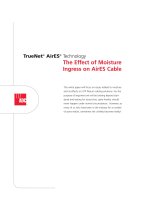Tài liệu The Elements of Fiber Cable Management pptx
Bạn đang xem bản rút gọn của tài liệu. Xem và tải ngay bản đầy đủ của tài liệu tại đây (220.05 KB, 4 trang )
WHITE PAPER
The Elements of
Fiber Cable Management
The Elements of
Fiber Cable Management
As service providers continue upgrading their networks to transport high-bandwidth
broadband services, an increase in fiber usage is essential to meet both bandwidth
and cost requirements. But just deploying this additional fiber is not enough
– a successful, well-built network must also be based on a strong fiber cable
management system.
Proper fiber management has a direct impact on the network’s reliability,
performance, and cost. Additionally, it affects network maintenance, operations,
expansion, restoration, and the rapid implementation of new services. The four
primary elements of a strong fiber cable management system provides bend radius
protection, cable routing paths, cable accessibility, and physical protection of the
fiber network. Executing these concepts correctly will enable the network to realize
its full competitive potential.
Introduction
With strong demand steadily increasing for broadband services that will include
several bandwidth-hungry technologies like high-definition television (HDTV) and
higher Internet speeds for handling larger file sharing requirements, fiber is being
pushed closer and closer to the customer premise. This, in turn, creates a need for
additional fiber in the central office (CO) /data center and the active equipment that
must be managed to accommodate future network growth.
Any new broadband network infrastructure must have the inherent capability to
easily migrate to the next generation of technologies and services. This is a key
consideration for multiple system operators (MSOs) that are beginning to deploy
triple-play broadband services – whether it’s from the MSO headend, a CO, or
wireless mobile switching center (MSC). As the amount of fiber dramatically
increases, the importance of properly managing the fiber cables becomes a more
crucial issue.
The manner in which fiber cables are connected, terminated, routed, spliced, stored,
and handled will directly and substantially impact the network’s performance and,
more importantly, its profitability. The four fundamental elements of fiber cable
management – bend radius protection, cable routing paths, accessibility, and physical
protection – will be discussed in this paper, as well as new technologies and products
that have been developed in the last few years to improve these elements.
Bend radius protection
There are two types of bends in fiber – microbends and macrobends – that can
affect the fiber network’s long-term reliability and performance.
The microbend is a small, microscopic bend which may be caused by the cabling
process itself, mechanical stress due to water in the cable during repeated freeze
and thaw cycles, packaging, or installation. External forces are also a source of
microbends. An external force deforms the cabled jacket surrounding the fiber, but
causes only a small bend in the fiber. A microbend typically changes the path that
propagating modes take, resulting in loss from increased attenuation as low-order
modes become coupled with high-order modes that are naturally lossy.
A macrobend is a larger cable bend that can be seen with the unaided eye
and is often
The Elements of Fiber Cable Management
Page 3
reversible. As the macrobend occurs, the radius can
become too small and allow light to escape the core and
enter the cladding. The result is insertion loss at best
and, in worse cases, the signal is decreased or completely
lost. Both microbends and macrobends can, however,
be reduced and even prevented through proper fiber
handling and routing.
The minimum bend radius will vary depending on the
specific fiber cable. However, in general, the minimum
bend radius of a fiber should not be less than ten times
its outer diameter. Thus, a 3-mm cable should not
have any bends less than 30 mm in radius. Telcordia
recommends a minimum 38 mm bend radius for 3-mm
patch cords. Also, if a tensile load is applied to a fiber
cable, such as the weight of a cable in a long vertical
run or a cable pulled tightly between two points, the
minimum bend radius is increased due to the added
stress.
The advent of bend insensitive fiber is an example of
how technology has addressed the bend radius issue.
Whereas the minimum bend radius should not be less
than ten times the outer diameter of the fiber cable in
typical fiber, bend insensitive fiber provides more leeway.
However, service providers must understand that these
new fibers do not diminish the need for solid fiber
cable management. On the contrary, the increase in the
sheer number of fibers being added to the system to
accommodate broadband upgrades makes bend radius
protection as important as ever.
As fibers are added on top of installed fibers,
macrobends can be induced on the installed fibers if they
are routed over an unprotected bend. A fiber that had
been working fine for many years can suddenly have an
increased level of attenuation, as well as a potentially
shorter service life. Although bend insensitive fiber is an
innovative breakthrough in addressing the issue of bend
radius protection, it may be some time before service
providers replace existing fibers with a bend insensitive
variety of fiber. Meanwhile, the importance of bend
radius protection is critical to avoid operational problems
in the network.
Cable routing paths
The second element of fiber cable management is cable
routing paths and is related to bend radius protection
because improper routing of fibers by technicians is one
of the major causes of bend radius violations. Wherever
fiber is used, routing paths must be clearly defined and
easy to follow – to the point where the technician has no
other option than to route the cables properly. Leaving
cable routing to the technician’s imagination leads to an
inconsistently routed, difficult-to-manage fiber network.
The quality of the cable routing paths, particularly within
a fiber distribution frame system, can be the difference
between congested chaos and neatly-placed, easily-
accessible, patch cords. It’s often said that the best
teacher in fiber routing techniques is the first technician
to route it properly. Conversely, the worst teacher is
the first to use improper techniques since subsequent
technicians are likely to follow his lead.
Well-defined routing paths, therefore, reduce the
proficiency training time required for technicians and
increase the uniformity of the work done by ensuring
and maintaining bend radius requirements at all points to
improve overall network reliability. It is important to note
that, again, the use of bend insensitive fiber does not
diminish the need for clear cable routing paths – there
are benefits that go beyond bend radius protection.
Having defined routing paths make accessing individual
fibers easier, quicker and safer – reducing the time
required for reconfigurations. Fiber twists are reduced
to make tracing a particular fiber for rerouting much
easier. Even with new technologies, such as the use of
LEDs at both ends of patch cords for easy identification,
well-defined cable routing paths still greatly reduce the
time required to route and reroute patch cords. All of
this directly affects network operating costs and the time
required to turn up or restore service.
Cable access
Cable access is the third element to good fiber cable
management and refers to the accessibility of the
installed fibers. As the number of fibers increases
dramatically in both the distribution frame and the
active equipment, cable access becomes an increasingly
important issue for broadband service providers. In the
past, an active equipment rack might have had about
50 fibers exiting, and managing those fibers was much
less of an issue. But as that same rack is fitted for next
generation broadband services, there may be upwards
of 500 fibers involved, making proper management and
accessibility a vitally important matter.
With huge amounts of data – as well as revenue
– moving across those fibers, the ability for technicians
to have quick and easy access is critical. When there
are service level agreements in place, particularly for
customers with high priority traffic, the last thing any
service provider wants is service interruptions caused by
mishandling one fiber to gain access to another.
As previously mentioned, there are patch cords designed
today with LEDs at both ends to help technicians identify
particular cable runs with no chance of error. These
innovations can be implemented into a good cable
management system to help minimize problems caused
by disconnecting the wrong patch cord. There are many
other tools and techniques for ensuring that every
fiber can be installed or removed without bending or
disturbing an adjacent fiber.
Website: www.adc.com
From North America, Call Toll Free: 1-800-366-3891 • Outside of North America: +1-952-938-8080
Fax: +1-952-917-3237 • For a listing of ADC’s global sales office locations, please refer to our website.
ADC Telecommunications, Inc., P.O. Box 1101, Minneapolis, Minnesota USA 55440-1101
Specifications published here are current as of the date of publication of this document. Because we are continuously
improving our products, ADC reserves the right to change specifications without prior notice. At any time, you may
verify product specifications by contacting our headquarters office in Minneapolis. ADC Telecommunications, Inc.
views its patent portfolio as an important corporate asset and vigorously enforces its patents. Products or features
contained herein may be covered by one or more U.S. or foreign patents. An Equal Opportunity Employer
104962AE 6/07 Original © 2007 ADC Telecommunications, Inc. All Rights Reserved
WHITE PAPER
The accessibility of the fibers in the fiber cable management system can mean the difference between
a network reconfiguration time of 20 minutes per fiber and one of over 90 minutes per fiber. Since
accessibility is most critical during network reconfiguration operations, proper cable access directly
impacts operational costs and network reliability.
Physical fiber protection
The last element of a fiber cable management system addresses the physical protection of the installed
fibers. Every fiber throughout the network must be protected against accidental damage by technicians
or equipment. Fibers traversing from one piece of equipment to another must be routed with physical
protection in mind, such as using raceway systems that protect from outside disturbances.
Without proper physical protection, fibers are susceptible to damage that can critically affect network
reliability. The fiber cable management system should always include attention to ensuring every fiber is
protected from physical damage.
A final word – planning
Finally, since many service providers are in the process – or soon will be – of upgrading networks for
delivering high-bandwidth broadband services, it is important to stress the need for planning in terms
of cable management. Today’s network is a living and growing entity – and what is enough today will
almost certainly be too little for tomorrow. With that in mind, future-proofing the network wherever
possible should be a major consideration – and fiber cable management is no different.
For example, the current upgrades to broadband service delivery taking place in COs, MSOs, or MSCs
is requiring more fiber deployment. Four- and six-inch fiber raceway systems are already becoming
inadequate to properly manage these larger amounts of fiber. Service providers must plan ahead for
a centralized, high-density fiber distribution frame line-up using 24-inch raceways that can not only
accommodate today’s fiber requirements, but also those expected in the future.
Although installing a 24-inch raceway system is more expensive today, the cost of having to go back
in and retrofit the system in a few years represents a much higher cost and significant risk to the fiber.
Ignoring future growth, particularly in terms of fiber, will result in higher long-term operational costs
resulting from poor network performance or a requirement to retrofit products that can no longer
accommodate network demand.
Another consideration in planning for good fiber cable management concerns the active equipment
rack. Most manufacturers have traditionally overlooked the need for providing cable management
within their equipment. Before purchasing, service providers should insist that cable management
is included within every piece of active equipment to ensure their investment will operate at peak
efficiently over time.
ADC is providing cable management options that wrap around the equipment of other
manufacturers. ADC offers products that address all four elements of a fiber cable
management system – bend radius protection, cable routing paths, cable access, and
physical protection – to strengthen the network’s reliability and functionality while
lowering operational costs and ensuring smooth upgrades when necessary.
WHITE PAPER









